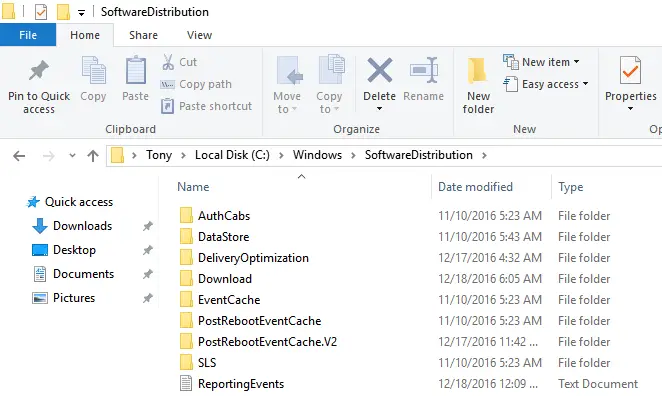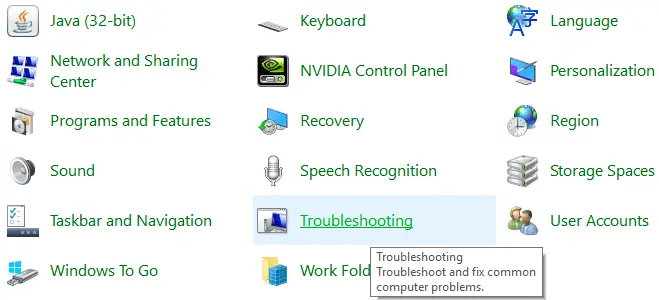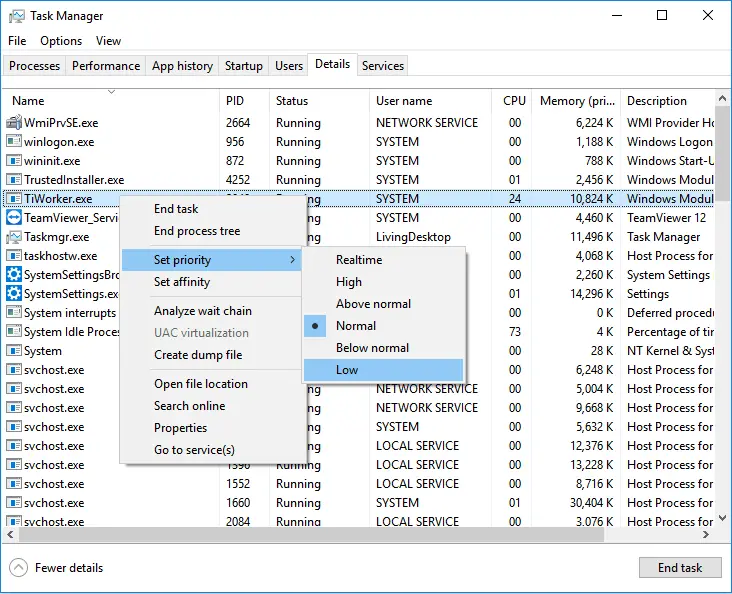Disclaimer: This post may contain affiliate links, meaning we get a small commission if you make a purchase through our links, at no cost to you. For more information, please visit our Disclaimer Page.
TiWorker.exe or also known as WMI Worker (Windows Module Installer Worker) – is the process of Windows Update service. It’s a required process in Windows and will start when booting up.
Typically, the TiWorker.exe will run in the background of Windows when checking for new updates. It won’t use your resource (CPU, RAM, Disk) until it actually works. When the update process is completed, TiWorker.exe will release your computer’s resources.
However, this process can sometimes also cause high PC’s resource usage, including CPU, RAM, and Disk, in Windows 8, 8.1 and Windows 10. Even Windows Update doesn’t run, TiWorker.exe also hogs the resources and makes it unusable.
Also Read: Fix Svchost.exe (netsvcs) High CPU Usage or Memory Leak Issues.
In this article, I will show you a few methods that you can use to diagnose and troubleshoot TiWorker.exe high CPU, RAM, or a Disk usage problem, with detailed instructions.
Fix TiWorker.exe High CPU, RAM Or Disk Usage Issue in Windows
1. Manually Check for Windows Update and Install Them
The first step to take to resolve TiWorker.exe (Windows Module Installer Worker) high usage problem is to check for Windows updates manually and install them if any exist.
To check for updates in Windows 8, 8.1, follow the instructions below:
- Press Windows + R to launch the Run dialog box.
- Type: “wuapp.exe” without the quotes and press Enter.
- In the Windows Update window, click on “Check for updates” in the left panel.
- Install all available updates if found.
- Restart your computer and verify whether the problem persists.
To check for updates in Windows 10, navigate to Settings -> Update & security -> Windows Update. Next, click on the “Check for updates” button, and then install all available updates.
2. Delete SoftwareDistribution Folder
SoftwareDistribution is also known as the Windows Update store folder, where it keeps downloaded updates for Windows.
If one of those files is damaged, then Windows Update can’t work properly. It can’t update features and improvements for Windows which will lead to many other issues, including TiWorker.exe high usage problem.
In this case, you have to force Windows to re-download updates again by deleting SoftwareDistribution folder. To do so, follow the instructions below:
- Press Windows + R to launch the Run dialog box.
- Type: “services.msc” without the quotes and press Enter.
- In the Windows Service window, search for “Windows Update” and stop it.
- Go to C:\Windows, find SoftwareDistribution folder and then delete it.
- Restart your computer and manually check for updates again. Install all updates if available.
- Reboot the computer again after installing updates.
3. Run Windows Update And System Maintenance Troubleshooters
3.A – Run Windows Update Troubleshooter
As the recommendation from Microsoft experts, run Windows Update troubleshooter will help to diagnose and troubleshoot problems related to Windows Update. That would be helpful to resolve TiWorker.exe high resources usage in Windows.
To get started, press Windows + X and then P to open Control Panel.
In the Control Panel window, choose “Troubleshooting“.
Look at the left panel, select “View all“.
Click on “Windows Update” from the list and open it.
Click on “Next” button and follow the onscreen instructions to diagnose and fix issues in Windows Update.
3.B – Run Windows System Maintenance Troubleshooter
To use System Maintenance troubleshooter from the Control Panel window, select “Troubleshooting” and then choose “System Maintenance“.
In the next step, click on “Next” button and then follow the onscreen instructions to use System Maintenance troubleshooter.
It will automatically diagnose your Windows system and resolve the problem if there is any available.
Reboot your Windows computer after running both troubleshooters above.
4. Scan and Fix Corrupted System Files
Sometimes, corrupted system files can cause this high resource usage problem in Windows. You can use SFC command in Command Prompt to scan and fix corrupted files.
To get started, press Windows + X, then A to open Command Prompt with administrator privilege.
If the User Account Control is enabled, then you have to choose “YES” to open Command Prompt.
In the Command Prompt window, type:
sfc /scannow
and press Enter.
You have to wait until the SFC scan process is completed and then reboot your computer. Check again whether TiWorker.exe is still using a lot of resources (CPU/Disk).
Note: When the SFC tool is scanning your computer, do not use it.
5. Use the DISM Tool to Fix Windows Corruption Errors
DISM Tool, also known as System Update Readiness Tool, is a tool to help you scan your Windows system to find corruption errors and fix them automatically.
This tool is also useful in case the SFC command finds corrupted files, but can’t fix them.
To use the DISM Tool, press Windows + X, then A to open Command Prompt with administrator privilege.
In the Command Prompt window, type:
Dism.exe /Online /Cleanup-Image /Restorehealth
or
Dism /Online /Cleanup-Image /RestoreHealth
Both commands are the same.
Wait for the process to complete and then reboot your computer to verify whether TiWorker.exe high resource usage problem persists.
You can also use Reimage Plus program to scan and repair any Windows system corrupted files. It’s a freeware! Visit here to find out further.
According to some users of Microsoft forum, scanning and repairing corrupted files helped them to resolve “System And Compressed Memory” high CPU usage problem in Windows 10. If you are encountering the same issue, I would recommend you use the above methods to scan and repair Windows corrupted files.
6. Set Priority Of TiWorker.exe to Low
If you are facing the TiWorker.exe high CPU usage problem and all methods above can’t help you to fix it, you can try to set the priority of this process to Low.
To do so, press Ctrl + Shift + Esc to open Task Manager.
Click on “More details” and then choose “Details” tab.
Find TiWorker.exe process, right-click on it and set the priority to Low.
If the TiWorker.exe (Windows Module Installer Worker) is still hogging the resource of your CPU or Disk, I would recommend you disable the Windows Update service. This is a temporary solution. You can use it and wait for the next Windows update and hope Microsoft will fix it.
If you have any questions regarding this article or TiWorker.exe process, please leave your comment below.



